Do you want to know about the history of blogging?
If you are thinking about starting a WordPress blog today, then you might like to know that there are 1.9 billion websites in the world, and the blogging industry makes up one-third of it. But it didn’t start out that way.
In this article, we’ll share the small beginnings of blogging, the powerful blogging platforms that evolved, and how WordPress came to power over 43% of all websites.
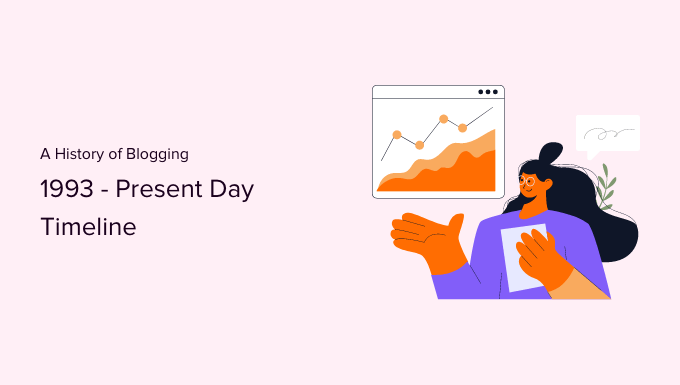
1993-1994: The First Blogs Were Published
Blogging was born sometime around 1993 or 1994. No one was expecting the impact it would have on the world, and the word ‘blog’ didn’t even exist. As a result, there were no historians watching out for it, and no one kept careful records.
We know that Rob Palmer started a plain text journal online in late 1993. In an article on how he became the first blogger, Rob explains how costly it was to run a website in those days. The domain name cost him $100, and basic hosting cost over $100 a month (for comparison, it costs $2.69 per month now).
However, it’s more widely recognized that the first blog was created by 19-year-old student Justin Hall. His home page contained hyperlinks to interesting content he found online, and articles he wrote himself. The content included basic HTML text formatting and small images.
Ten years later, the New York Times Magazine named him the “founding father of personal bloggers”. You can still find an early version of Justin’s page preserved on links.net.
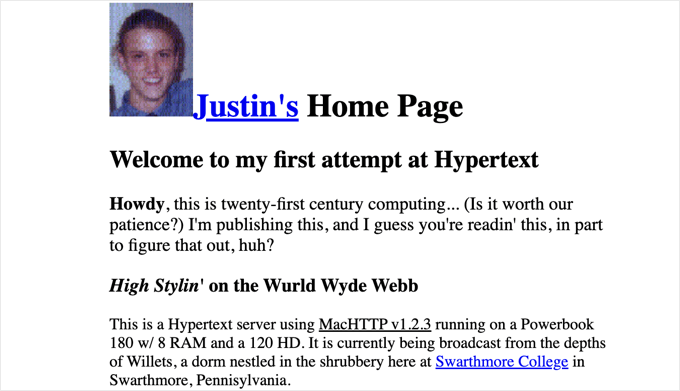

Three or four years later, the tech blog SlashDot was launched in September 1997.
December 1997: The Term ‘Weblog’ Was Coined
Originally, blogs didn’t have a name. They were thought of as online journals or diaries, or personal home pages.
In December 1997, Jorn Barger came up with the term ‘weblog’. He maintained an internet culture website called Robot Wisdom, and the term reflected his process of ‘logging the web’ as he browsed.
August 1998 was the first time a traditional news site tried blogging. Journalist Jonathan Duke ‘blogged’ about Hurricane Bonnie for the Charlotte Observer, but didn’t use the term itself.
October 1998: The Open Diary Platform Was Launched
Creating websites was technical, so eventually blogging platforms were created that made it easy for users to record their thoughts and experiences online.
One of the earlier ones was The Open Diary, which developed an online community by allowing users to comment on one another’s posts.
Here’s an early screenshot preserved on the Internet Archive. Notice that blogs were designed for much lower-resolution screens back then.
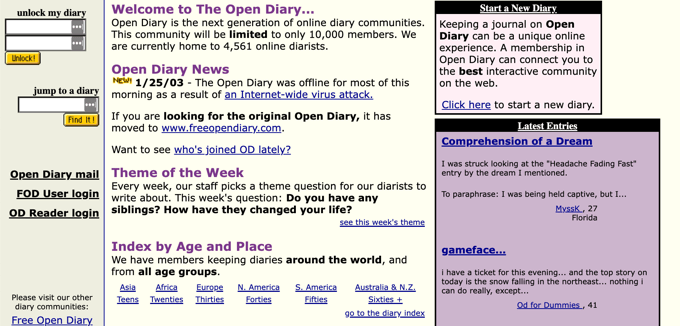

March 1999: RSS Made Blog Subscription a Reality
RSS is an abbreviation for Really Simple Syndication or Rich Site Summary. It was initially released in March 1999 and is a format used for delivering frequently changing web content from websites and other online publishers.
It allows users to keep track of updates to their favorite websites without having to visit each site individually. They are able to read the latest content in an RSS feed reader or their email.
You can use RSS to grow your blog by following our guide on how to use RSS in WordPress.
In April 1999, developer Peter Merholz added some humor to his website, Peterme.com. He broke up the word ‘weblog’, into two words, ‘we blog’. This caught on, and the term ‘blog’ was born.
April 1999: LiveJournal, an Early Blogging Platform, Was Launched
In April 1999, programmer Brad Fitzpatrick launched the LiveJournal platform as a way to keep in touch with his high school friends. It quickly grew into a community of people recording their thoughts online.
LiveJournal was easy to use because it provided a single open text area. Its competitors at the time offered form-based text fields.
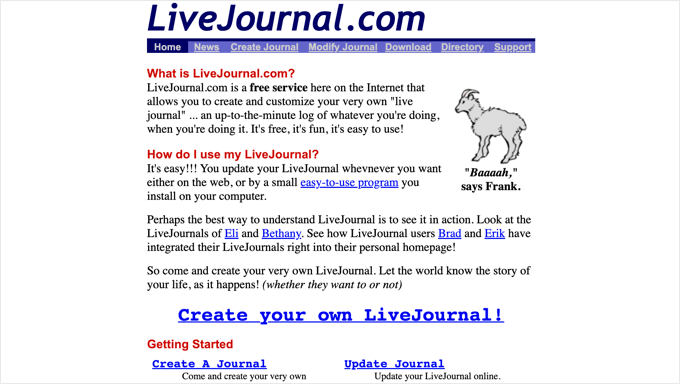

In January 1995, the blogging company Six Apart purchased the company that operated LiveJournal, and the platform is still operating today. Although a lot of LiveJournal users have switched to WordPress by following our guide on how to move from LiveJournal to WordPress because WordPress is more powerful and easier to use.
In July 1999, another blogging platform called Metafilter was launched. It was known as MeFi, and its members could post entries to be published on the main website.
August 1999: Blogger Was Launched by Para Labs
Blogger is another early blogging platform, first launched in August 1999 by Pyra Labs. It offered a quick and easy way to create a blog for non-tech-savvy users.
Every entry on Blogger was given a permanent and shareable URL or permalink. This made it easy for users to access the content they were searching for and made Blogger the platform of choice for a lot of writers.


Later in 2003, Google acquired Blogger and over time redesigned it into the product we know today. It is WordPress’s largest competitor, and you can learn more in our comparison of WordPress vs Blogger (Pros and cons).
In January 2000, the first known vlog entry was created by Adam Kontras, and also the popular blog Boing Boing was born.
Early 2001: b2/cafelog, the Precursor of WordPress, Was Launched
In early 2001, the French programmer Michel Valdrighi launched a personal publishing system with a new design known as b2 or cafelog.
In contrast with most other blogging systems at the time, the software needed to be installed on the user’s own web server, and it dynamically created pages from the contents of a MySQL database. WordPress users will find this familiar.
b2/cafelog became popular and was eventually installed on about 2,000 blogs. Unfortunately, the project was abandoned, paving the way for its source code to form the basis of WordPress in 2003.


October 2001: The Moveable Type Blogging Platform Was Released
The company Six Apart launched the Moveable Type blog publishing system in October 2001. Like b2, it needed to be installed on a web server. They introduced a trackback system in version 2.2 that has been adopted by other blogging platforms including WordPress.
In February 2002, Heather Armstrong lost her job for writing about her work colleagues on her personal blog, dooce.com. As a result, ‘dooced’ has become a term that means ‘fired for blogging.’
April 2002: TheMommyBlog.com Was Founded
In April 2002, Melinda Roberts started TheMommyBlog.com, one of the first blogs focussing on parenting and family life. This would inspire more than 3.9 million other parenting blogs over the next ten years.
This highlights how successful some blogging niches can become. Learn how to select the right niche for your blog in our guide on the best blogging niches that will make money.
The popular Gizmodo blog was also launched in July 2002.
August 2002: Blogads Allowed Blogs to Be Easily Monetized
Blogads, the first broker of blog advertising, launched in August 2002. This allowed many bloggers to turn their hobby into their primary source of income.
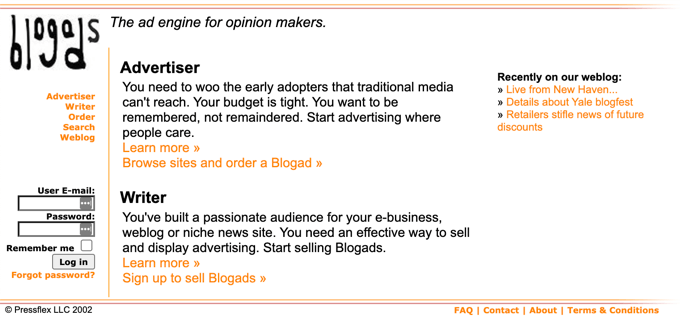

You can learn to do the same in our guide on how to sell ads on your WordPress blog.
Less than a year later, Google launched AdSense, a competing platform.
November 2002: The Blog Search Engine Technorati Was Launched
Technorati provided a search engine for bloggers in November 2002, allowing blog readers to easily find useful content. In 2008, Technorati also launched an ad network.
Gawker, the first gossip blog, was launched in December 2002. It ceased operations in August 2016 after a legal battle and was later relaunched in July 2021.
February 2003: The Birth of Live Blogging
In February 2003, The Guardian made use of live blogging during the Prime Minister’s question time. They called this ‘live text’ and started to use it frequently for sporting events.
Today live blogging has taken many forms from self-hosted live blogs done on CNN and other blogs, to even real-time tweets which in essence are a form of live blog.
If you’re looking to start live blogging on your own website, then see our step-by-step guide on how to do live blogging in WordPress.
February 2003: Blogger Was Acquired by Google
In February 2003, Google acquired Blogger, which was at that time the biggest and most successful blogging platform. It continued to grow in popularity until mid-2010.
However, since then WordPress steadily rose in popularity, and has been beating Blogger and dominating the trends since 2014.
Blogger remains the second most popular platform used by about 0.4% of blogs, while WordPress used is by an astonishing 97%.
In March 2003, an anonymous Iraqi blogger known as ‘Salam Pax’ blogged about the Iraq War to a worldwide audience.
May 2003: WordPress Was Released
In May 2003, Matt Mullenweg and Mike Little released the first version of WordPress. It was based on the code of an earlier blogging platform, b2/cafelog, that they were involved in. The new software retained the best parts of the older platform and added new features.
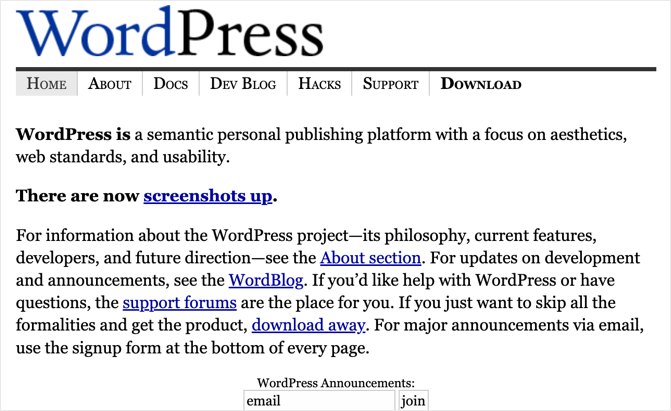

Like b2/cafelog, the software needed to be installed on a web hosting server, and dynamically created web pages from a MySQL database, just as the current version of WordPress does.
One goal of the platform was to be easy to set up. Here’s a preview of the WordPress 1.0 basic settings screen:


If you’d like to see how WordPress came to power 43% of websites, then see our guide on the history of WordPress. You can also see how WordPress features have developed over the years in our guide on the evolution of the WordPress user interface.
June 2003: Google Adsense Was Launched
After purchasing Blogger, Google launched its online advertising platform Adsense in June 2003. Its unique feature was to match ads with blog content, and it made it easy for bloggers to start making money.
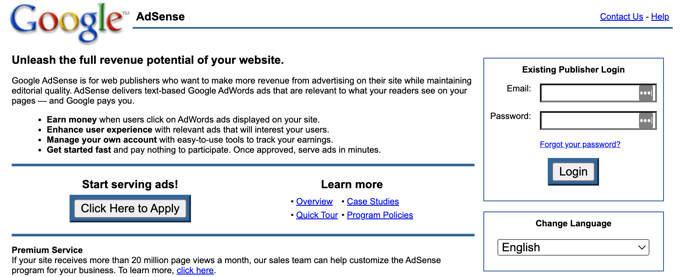

Google Adsense is still a leading ad platform for bloggers. You can learn how to use it in our guide on how to properly add Google AdSense to your WordPress site.
Jason Calacanis founded Weblogs, Inc. in September 2003. It eventually grew into a portfolio of 85 blogs. In 2005 he sold the company to AOL for $30 million.
TypePad, a commercial blogging platform based on Moveable Type, was released in October 2003 and hosted blogs for major multimedia companies such as the BBC.
February 2004: The Year of the Video Blog
In February 2004, videographer Steve Garfield started to upload one or two short videos each month to his personal blog. These often covered news events such as protests and rallies.
Other video bloggers started doing the same, and this became known as ‘vlogging.’ Steve Garfield dubbed 2004 ‘the year of the video blog.’
This led the way for YouTube to be launched the following year.
In May 2004, WordPress 1.2 was released, introducing a new plugin architecture.
In September 2004, Darren Rowse launched ProBlogger.net.
December 2004: ‘Blog’ Was the Merriam-Webster Word for the Year
In 2004, the most looked-up word in the Merriam-Webster online dictionary was ‘blog’. It became their word for the year.
This shows how much blogging was impacting the mainstream world. In fact, 32 million Americans were reading blogs at the time according to one study.


In February 2005, WordPress 1.5 was released, introducing themes.
February 2005: YouTube Was Launched
With the growth of video blogging, YouTube was launched in February 2005. This made it much easy for users to upload video content to the internet.
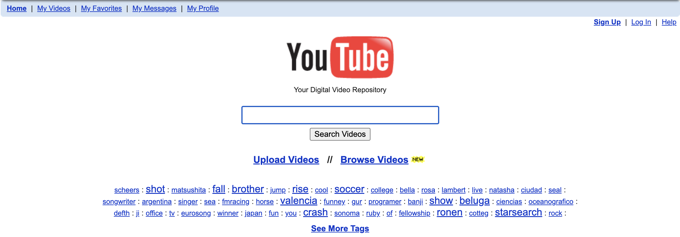

It would be purchased by Google the following year.
Blogging continued to grow in credibility. In March 2005, Garrett Graff became the first blogger to be granted a press pass for the White House. The popular tech blog TechCrunch was launched in June 2005, and Mashable the following month.
August 2005: Automattic Was Founded
In August 2005, WordPress co-founder Matt Mullenweg founded a new company, Automattic. The following year, it launched a new blog hosting service known as WordPress.com.
This allowed you to create a WordPress blog for free, but without the advanced features of self-hosted WordPress. You could purchase additional options like a custom domain name, additional storage, and other premium services.
Because of the similarity in names, beginners often start with WordPress.com thinking they are getting the powerful WordPress.org software.
After seeing the limitations, users often end up switching from WordPress.com to WordPress.org to have more features, ease of use, and control over their website.
In December 2005, it was estimated that $100 million worth of blog ads were sold that year. Also, WordPress 2.0 was launched, introducing the new admin dashboard.
November 2005: Google Analytics Was Launched
To create a successful blog, it’s helpful to know how users interact with your website, including the blog posts they enjoy and those they don’t. In November 2005, Google Analytics was launched to help website owners track user activity.
It was initially developed from other analytics software acquired by Google, including Urchin on Demand and Adaptive Path, and additional features were added in the following years.
You can learn how to track the activity of visitors to your own blog by following our guide on how to track user engagement in WordPress with Google Analytics.
March 2006: Launch of Twitter, the Popular Microblogging Platform
In March 2006, Jack Dorsey co-founded Twitter and sent out the first tweet. This new platform restricted posts to 140 characters or less, introducing the concept of microblogging.


You can use WordPress Twitter plugins to include your recent tweets on your website or encourage visitors to share your blog posts.
Automattic filed for trademark registration for the WordPress name and logo in March 2006. At the time there were 50 million blogs on the internet according to Technorati.
August 2006: The First WordCamp Was Held in San Fransisco
WordCamps are locally-organized conferences covering everything related to WordPress. The first WordCamp was organized in San Francisco by Matt Mullenweg in August 2006.
Since then local communities around the world have organized hundreds of others. If you would like to attend one, you may be interested in our infographic on what a WordCamp is and why you should attend.
October 2006: Wix Hosted Blogging Platform Was Launched
Wix was launched in October 2006. It is a popular hosted platform that offered a drag-and-drop website builder, allowing small businesses to easily build a website without coding skills. However, themes were limited, and you had to pay for every third-party plugin.
Wix currently has over 110 million users across the globe. Learn how it compares with WordPress in our article on Wix vs WordPress.
Google acquired YouTube in October 2006.
February 2007: Tumblr Microblogging Platform Was Released
Tumblr was launched in February 2007. It’s a microblogging platform with social networking features including following other blogs, reblogging, built-in sharing tools, and more.


The platform was purchased by Yahoo in 2013, then acquired by Verizon in 2017. It is currently owned by Automattic.
If you’re a Tumblr user looking to move to a new platform, you can see our guide on how to properly move your blog from Tumblr to WordPress.
Posterous, a similar microblogging platform, was launched in May 2008. On an unrelated note, the White House started its own blog in January 2009.
July 2009: WPBeginner Was Launched
In July 2009, the WPBeginner blog was launched by 18-year-old web developer Syed Balkhi. He decided that instead of maintaining his clients’ WordPress websites, he would teach them to do it themselves.
He scoured the web to find a resource that could help his clients and other new WordPress users, but most WordPress tutorials were written by developers for developers. So he created WPBeginner as a resource targeted toward WordPress beginners and DIY users.
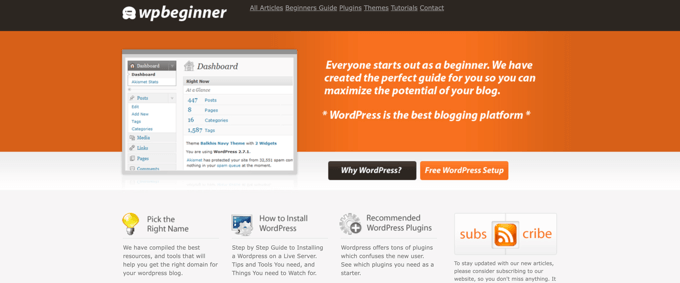

Since then, WPBeginner has become the largest free WordPress resource site in the industry.
In June 2010, Automattic donated the ‘WordPress’ trademark to WordPress.org. By the end of the year, there were more than 152 million blogs across all platforms and 11% of bloggers were earning their primary income from blogging.
August 2012: Medium Was Launched
Evan Williams, a co-founder of Pyra Labs which created Blogger, launched a different type of blogging platform called Medium. It works like a social network where you can publish articles.


Medium has grown into a community of writers, bloggers, journalists, and experts. It is an easy-to-use blogging platform with limited social networking features.
However, while the platform looks attractive at first, the lack of monetization and control leads to most people switching from Medium to WordPress. To learn which platform matches your needs, see our guide on WordPress vs Medium – which one is better?
April 2013: Ghost Minimal Blogging Platform Was Launched
Ghost is a minimalist blogging platform with features entirely focused on writing blog posts. It was launched in April 2013 and is available as a hosted platform, and also a version that you can host on your own server, though this is tricky.


Ghost now has over 3 million installs with an active monthly user base of over 10,000. You can learn how it compares with WordPress in our WordPress vs Ghost guide.
In April 2013, LinkedIn acquired the Pulse blogging platform, which was rolled out to all users over the next couple of years.
September 2013: OptinMonster Was Launched
In September 2013, Syed Balkhi and Thomas Griffin co-founded OptinMonster, the most powerful conversion optimization software. It was designed to help bloggers grow their email lists in WordPress and convert website visitors into subscribers.
Over the years, Syed had tried numerous techniques to get more email subscribers. He was able to get 70–80 new subscribers each day by adding a sidebar form, contact form, and other landing pages to his site.
When he started using OptinMonster, he started getting 600% more email subscribers even though his blog was getting the same amount of traffic as before.
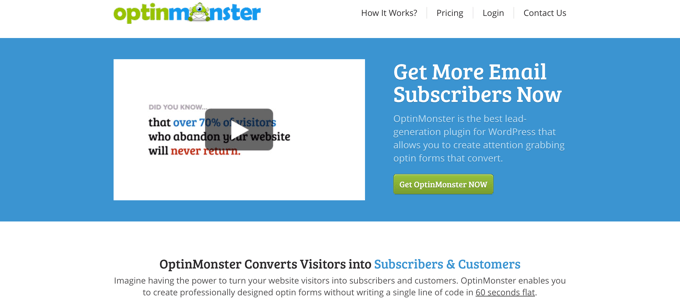

OptinMonster is now used on over 1.2 million websites. You can learn how to use it by following our guide on how to build your email list in WordPress with OptinMonster.
In April 2015, there were more than 227 million blogs worldwide.
March 2016: WPForms Was Launched
The following year, Syed Balkhi co-founded another product, this time with Jared Atchison. WPForms is a powerful WordPress plugin that makes it easy for bloggers to create forms using templates and drag and drop.
You can easily create a contact form, online survey form, email subscription form, donation form, billing order form, or any other type of form with just a few clicks without hiring a developer or learning how to code.


You can learn how to get started with WPForms on your own blog by following our step-by-step guide on how to create a contact form in WordPress.
April 2016: MonsterInsights Was Launched
In April 2016, Syed Balkhi acquired Yoast Analytics, the most popular Google Analytics integration in the world, and rebranded it as MonsterInsights. The plugin allows you to easily install Google analytics in WordPress and shows you helpful reports in your dashboard.
Google Analytics shows you how your audience interacts with your website, which is crucial for a successful blog. The best part about using MonsterInsights is that you can add the Google Analytics tracking code without editing code or hiring a developer.


You can learn how to install Google Analytics on your blog using MonsterInsights in our guide on how to install Google Analytics in WordPress.
In May 2016, WordPress introduced the .blog domain extension as an alternative to .com, .net and .org. By February 2017, there were more than 300 million blogs online.
November 2017: Substack Was Founded
Substack, an online newsletter publishing platform, was founded in November 2017. It allows you to easily send newsletter emails to your subscribers.
You can have both paid and free subscriptions, and Substack gets a share of all your paid subscription fees. Apart from newsletters, you also get a basic website and podcast hosting.
However, Substack doesn’t have all the functionality of a typical blogging platform or a content management system. You can learn how it compares with WordPress in our guide on Substack vs WordPress: which one is better?
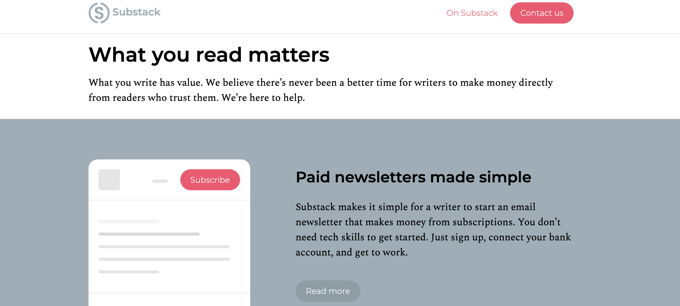

WordPress 5.0 was released in December 2018 and introduced the block editor, codenamed Gutenberg.
October 2018: SeedProd Joined Awesome Motive
In October 2018, SeedProd, the popular coming soon and maintenance mode plugin for WordPress joined Awesome Motive through a merger, along with the plugin’s founder, John Turner. At the time it was used by 800,000 WordPress sites.
The plugin was launched in 2011 and allows bloggers to easily create custom landing pages and layouts using a drag-and-drop builder interface. You can see how it works by following our guide on how to create beautiful coming-soon pages in WordPress using SeedProd.
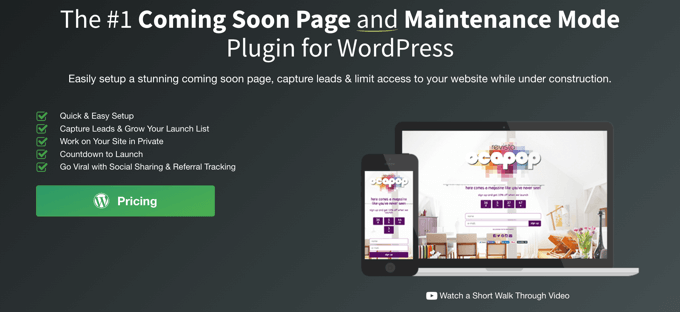

To celebrate the tenth anniversary of the WPBeginner blog, the WPBeginner Engage Facebook Group was launched in April 2019. It currently has over 89,000 members and is the largest WordPress group on Facebook.
February 2020: All in One SEO Acquired by Awesome Motive
In January, Awesome Motive acquired All in One SEO (AIOSEO), the original WordPress SEO plugin that was being used by over 2 million websites at the time.
The plugin was released in 2007 by Michael Torbert and allows you to easily optimize your WordPress blog for search engines and social media platforms.
To learn how to make the most of the plugin, see our guide on how to set up All in One SEO for WordPress correctly.
Later that year, PushEngage a leading web push notification software was acquired by Awesome Motive to help more bloggers use push notification to notify their users about new blog posts.
Web push notifications have become one of the most effective way to notify blog subscribers about new content, and it’s used by large news sites and publishers.
July 2021: SearchWP Acquired by Awesome Motive
Awesome Motive made another acquisition in July 2021: SearchWP, the leading search engine plugin for WordPress. It was originally developed in 2013 by Jon Christopher.
Effective site search is important to bloggers. It allows their users to find what they’re looking for, resulting in more sales and page views.
To learn how to use the plugin on your website, see our guide on how to improve WordPress search with SearchWP.
By 2022, 43% of the web was built on WordPress. There were 572 million blogs globally, and over 31 million bloggers in the US alone. For more statistics like this, see our list of blogging statistics, trends, and data.
July 2023: End of Life for Google Analytics UA
Google Analytics 4 is the latest version of Google’s analytics platform. It has many changes, like a new reporting system and metrics. The way GA4 collects and processes data is also different from the previous version known as Universal Analytics (UA).
Google will sunset the old Universal Analytics on July 1, 2023. It’s important to switch your blog over to the new version before then.
You can learn everything you need in our ultimate guide to GA4 in WordPress for beginners.
We hope this article helped you learn about the history of blogging. If you have additional blogging history facts, please let us know by leaving a comment below.
You may also want to learn how to choose the best blogging platform, or check out our list of ways to make money online blogging with WordPress.
If you liked this article, then please subscribe to our YouTube Channel for WordPress video tutorials. You can also find us on Twitter and Facebook.


